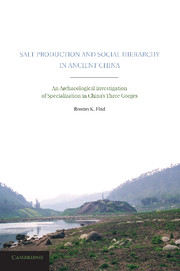 Salt Production and Social Hierarchy in Ancient China
Salt Production and Social Hierarchy in Ancient China Book contents
- Frontmatter
- Contents
- List of Figures and Tables
- Acknowledgments
- Prologue
- 1 Introduction
- 2 Production and Specialization in Complex Societies
- 3 Ancient Salt Production in Sichuan
- 4 The Zhongba Site
- 5 Ceramic Evidence
- 6 Parameters of Production According to Ceramics
- 7 Features and Spatiality
- 8 Animal Remains and Divination
- 9 Conclusions and Implications
- Epilogue
- Appendix A Chinese and Japanese Term List
- Appendix B The (t) Value and Average Thickness for Each Level Excavated in DT0202
- Appendix C Calculating the Scale of Production Using Briquetage from DT0202
- Appendix D Taxon List for Specimens Recovered from DT0202 with Number of Identified Specimens and Minimum Number of Individual Count by Phase and Subphase
- Notes
- Bibliography
- Index
9 - Conclusions and Implications
Published online by Cambridge University Press: 07 September 2011
- Frontmatter
- Contents
- List of Figures and Tables
- Acknowledgments
- Prologue
- 1 Introduction
- 2 Production and Specialization in Complex Societies
- 3 Ancient Salt Production in Sichuan
- 4 The Zhongba Site
- 5 Ceramic Evidence
- 6 Parameters of Production According to Ceramics
- 7 Features and Spatiality
- 8 Animal Remains and Divination
- 9 Conclusions and Implications
- Epilogue
- Appendix A Chinese and Japanese Term List
- Appendix B The (t) Value and Average Thickness for Each Level Excavated in DT0202
- Appendix C Calculating the Scale of Production Using Briquetage from DT0202
- Appendix D Taxon List for Specimens Recovered from DT0202 with Number of Identified Specimens and Minimum Number of Individual Count by Phase and Subphase
- Notes
- Bibliography
- Index
Summary
Specialized production of salt began at Zhongba in the Late Neolithic and continued throughout the Bronze Age. The production process changed radically twice. After each change, the ceramic assemblage at the site was dominated by a fundamentally new and different type of briquetage. Likewise, the organization of production was constantly changing, sometimes subtly, sometimes more dramatically.
These changes relate to other shifts in the behavior and activities of the people working at the site and also to the composition of the population living and working at Zhongba. Whereas salt production during the late Neolithic (Phase I) was probably conducted by relatively small kin groups on a part-time and/or seasonal basis for local exchange, the Bronze Age (Phases II and III) saw the development of increasingly large-scale production that involved the emergence of full-time producers who were manufacturing salt for long-distance trade and perhaps for the production of other commodities such as salted meat and fish and fermented fish sauce. This production seems to have been managed, and possibly controlled, by a segment of the population whose authority was based in part on their control of ritual knowledge and divinatory ability.
- Type
- Chapter
- Information
- Salt Production and Social Hierarchy in Ancient ChinaAn Archaeological Investigation of Specialization in China's Three Gorges, pp. 220 - 230Publisher: Cambridge University PressPrint publication year: 2011


